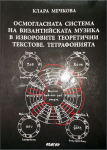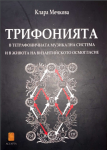n_antonov
Nikola Antonov
Dear friends, I would like to present to you two books by Bulgarian researcher musicologist and professor of music history Klara Mechkova.
Over the last decade, she has published two books on Tetraphony and Triphony as the major systems of the Byzantine music.
1. The Oktaechon System of the Byzantine Music in the Theoretical Texts Sources. The Tetraphony (2009). The book follows strictly the medieval Byzantine sources. The researcher examines in detail key issues of Byzantine music theory, makes a detailed and in-depth analysis of the St. John Kukuzel's wheel (Τροχός). She pays special attention to terms and issues such as φωνή, ήχος (functional theory of the echos), the discrepancy between the order and naming of the Ancient Greek scales and Byzantine scales, the relation between music and theology in the medieval Byzantium.
2. The Triphony in the Tetraphonic Musical System and in the Life of the Byzantine Oktaechon (2018). The book is a continuation of the first with an emphasis on the Triphony as a subsystem of the Byzantine music. The author makes a detailed analysis on the graphic of John Plusiadinos (Η σωφοτάτη παραλλαγή). Also, in this book she translates and analyzes the δοξαστικό Θεαρχίω νεύματι by various Byzantine sources. She pays special attention to terms such as φθορά, νανά, λέγετος, νενανώ and others key concepts. The question about the tonal system is also addressed in this book. She mentions the testimony of Chrysanthos about the three types of tonal intervals and traces the connection with the sources of Arabic music in the Middle Ages. It suggests that Arab musicians may have borrowed the idea of the intervals from the medieval Byzantium (there is no direct evidence, so this remains only a scientific assumption and hypothesis).
The Klara Mechkova's research focus is on the musical systems, functional analysis and the way these major components of music work, following strictly Byzantine music sources. In addition, she has deep knowledge and gives credit to the Three Teachers' reform. On one hand, she traces the continuity between medieval Byzantine music and the music of The Modern Times (the Three teachers' reform). On the other hand, she does not make the mistake of fully identifying or completely negating any connection between the Middle Ages and Modern Times (as many Western researchers make).
Unfortunately, Klara Mechkova's books are only available in Bulgarian for the time being.
Over the last decade, she has published two books on Tetraphony and Triphony as the major systems of the Byzantine music.
1. The Oktaechon System of the Byzantine Music in the Theoretical Texts Sources. The Tetraphony (2009). The book follows strictly the medieval Byzantine sources. The researcher examines in detail key issues of Byzantine music theory, makes a detailed and in-depth analysis of the St. John Kukuzel's wheel (Τροχός). She pays special attention to terms and issues such as φωνή, ήχος (functional theory of the echos), the discrepancy between the order and naming of the Ancient Greek scales and Byzantine scales, the relation between music and theology in the medieval Byzantium.
2. The Triphony in the Tetraphonic Musical System and in the Life of the Byzantine Oktaechon (2018). The book is a continuation of the first with an emphasis on the Triphony as a subsystem of the Byzantine music. The author makes a detailed analysis on the graphic of John Plusiadinos (Η σωφοτάτη παραλλαγή). Also, in this book she translates and analyzes the δοξαστικό Θεαρχίω νεύματι by various Byzantine sources. She pays special attention to terms such as φθορά, νανά, λέγετος, νενανώ and others key concepts. The question about the tonal system is also addressed in this book. She mentions the testimony of Chrysanthos about the three types of tonal intervals and traces the connection with the sources of Arabic music in the Middle Ages. It suggests that Arab musicians may have borrowed the idea of the intervals from the medieval Byzantium (there is no direct evidence, so this remains only a scientific assumption and hypothesis).
The Klara Mechkova's research focus is on the musical systems, functional analysis and the way these major components of music work, following strictly Byzantine music sources. In addition, she has deep knowledge and gives credit to the Three Teachers' reform. On one hand, she traces the continuity between medieval Byzantine music and the music of The Modern Times (the Three teachers' reform). On the other hand, she does not make the mistake of fully identifying or completely negating any connection between the Middle Ages and Modern Times (as many Western researchers make).
Unfortunately, Klara Mechkova's books are only available in Bulgarian for the time being.
Attachments
Last edited:


